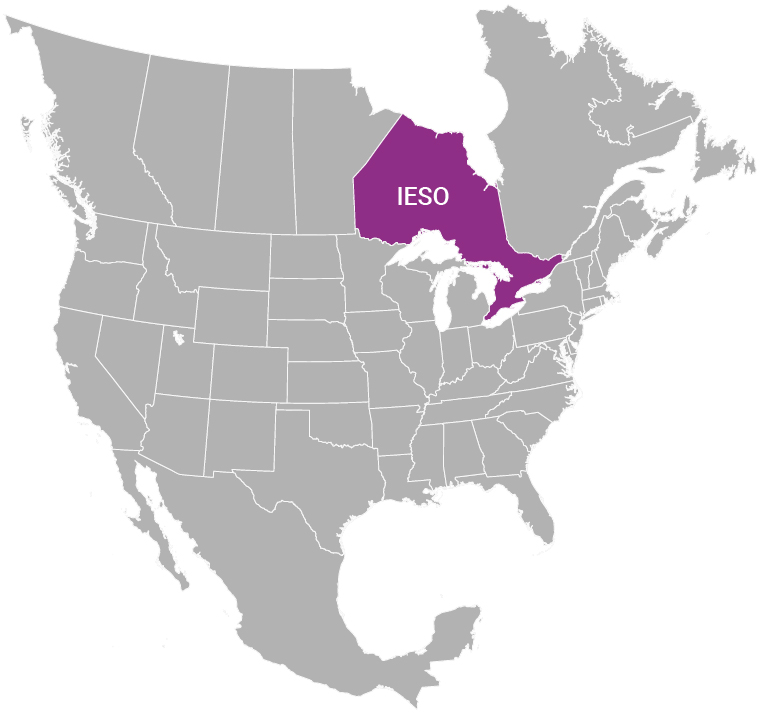The Ontario Day-Ahead Market (DAM) is a cornerstone of the province’s electricity market, designed to boost efficiency, ensure price certainty, and maintain a reliable power supply. Operated by the Independent Electricity System Operator (IESO), the DAM is a key element of the Market Renewal Program (MRP), which modernizes Ontario’s electricity system. This blog dives into what the DAM is, how it functions and its benefits. It also introduces a powerful upcoming tool for traders and provides insights for stakeholders.

What is the Ontario Day-Ahead Market?
The Ontario DAM is a financially binding market where electricity suppliers, consumers and other participants submit bids and offers to buy or sell power for the following day. Unlike the earlier Day-Ahead Commitment Process (DACP), which prioritized reliability, the DAM creates a financially binding schedule that aligns pricing and dispatch for greater efficiency. It operates alongside the real-time market, enabling better planning and optimization of electricity supply and demand 24 hours in advance. Introduced as part of the IESO’s Market Renewal Program, the DAM transitioned Ontario to a single-schedule market with locational marginal pricing (LMP), effective May 1, 2025. This shift enhances market transparency and reduces inefficiencies [1].
How Does the DAM Work?
The DAM follows a clear process:
- Bids and offers submission: By 10:00 AM EST the day before the operating day, participants—dispatchable generators, loads, importers and exporters—submit bids and offers specifying quantities and prices for each hour of the next day.
- Market clearing: The IESO’s calculation engine determines the most cost-effective, security-constrained schedule for the next 24 hours, factoring in bids, offers and constraints like transmission limits.
- Binding schedules: The cleared DAM schedule commits participants to their production or consumption, offering price certainty and operational clarity.
- Settlement: Participants settle based on differences between their day-ahead schedule and real-time operations, using locational marginal prices. This two-settlement system reduces discrepancies and out-of-market payments.
- Real-time integration: The DAM works with the real-time market, where five-minute adjustments balance supply and demand, minimizing the need for costly real-time interventions.
Key Features of the DAM
- LMP: Prices reflect the cost of producing and delivering electricity at specific locations, factoring in congestion and losses.
- Single schedule market: Aligns pricing and dispatch, eliminating inefficiencies of the prior two-schedule system.
- Financial commitments: Dispatchable resources receive guarantees to cover costs if they adhere to schedules.
- Intertie transactions: Importers and exporters participate, with optimized schedules for imports and linked wheel transactions.
What are the Benefits of the DAM?
- Price certainty: Participants know next-day prices, aiding planning and reducing financial risks [2].
- Operational efficiency: The IESO gains better visibility into supply and demand, reducing reliance on real-time adjustments.
- Cost savings: The MRP, including the DAM, is projected to save $700 million over its first decade by optimizing resources and minimizing out-of-market payments [1].
- Transparency: Locational pricing signals the true cost of electricity, encouraging efficient decisions.
- Support for renewables: The DAM accommodates diverse energy sources, aligning with Ontario’s clean energy goals.
Challenges and Considerations
- Transition complexity: Shifting from DACP to a financially binding DAM requires participants to adapt to new systems and rules.
- Stakeholder input: Ongoing engagement is critical, as seen in refinements to thermal state transition periods [4].
- Data access: Some stakeholders seek more public data, like bid details, to enhance competitiveness [6].
Who Participates in the DAM?
The DAM involves a range of stakeholders:
- Dispatchable generators: Offer to supply electricity, gaining production certainty.
- Dispatchable loads: Large consumers bid to buy power, adjusting consumption based on prices.
- Importers and exporters: Enable cross-border trade with regions like New York, Michigan and Quebec.
- Non-dispatchable participants: Submit forecasts or schedules without real-time responsiveness.
- Wholesalers and retailers: Trade electricity without owning physical assets [3].
Introducing Enverus Nodal Renewable Forecast: A Game-Changer for Traders
As Ontario’s grid evolves with more renewable energy, tools like the upcoming Enverus Nodal Renewable Forecast will empower traders to stay ahead. This innovative solution will provide hourly wind and solar forecasts for key markets, including ERCOT, MISO, SPP, CAISO, NYISO, ISONE, SERC, WECC, PJM, and soon IESO, with capabilities to support day-ahead and real-time trading strategies across renewable-heavy markets.
How Nodal Renewable Forecast Benefits Traders:
- Granular insights: Using physics-based models, it delivers forecasts at the farm and node levels, adapting to new renewable assets without retraining.
- Strategic edge: Traders can analyze supply from current and planned renewable farms, identifying new opportunities for day-ahead virtual trading.
- First principles approach: Predicts resource availability absent curtailments or outages, enabling integration with power-flow models to solve for congestion.
Be the First to Know
The Enverus Nodal Renewable Forecast isn’t available yet, but we’re excited to bring it to market soon! Want to stay informed? Share your contact details with us, and we’ll notify you the moment it’s ready, ensuring you’re among the first to leverage its cutting-edge insights for trading success. Sign up here to join our waitlist!
The Bigger Picture: Market Renewal Program
The DAM is a pillar of the IESO’s Market Renewal Program, alongside the Single Schedule Market and Enhanced Real-Time Unit Commitment. These reforms create a transparent, robust market that delivers value to ratepayers. By addressing inefficiencies, the MRP supports Ontario’s growing energy needs and integrates technologies like energy storage and renewables [1].
Conclusion
The Ontario DAM is a transformative step toward a more efficient, reliable and sustainable electricity system. With price certainty, optimized resources and tools like the forthcoming Enverus Nodal Renewable Forecast, it empowers stakeholders to navigate a renewable-driven future. For more on the DAM, visit the IESO’s Market Renewal page at www.ieso.ca.
About Enverus Power and Renewables Grid Analytics and Forecasting Solutions
With a 15-year head start in renewables and grid intelligence, real-time grid optimization to the node, and unparalleled expertise in load forecasting that has outperformed the ISO forecasts, Enverus Power and Renewables is uniquely positioned to support all power insight needs and data-driven-decision making. More than 6,000 businesses, including 1,000+ in electric power markets, rely on our solutions daily.
References
- IESO Market Renewal: www.ieso.ca
- IESO Day-Ahead Market: www.ieso.ca
- IESO Real-Time Energy Market: www.ieso.ca
- IESO Market Renewal Newsletter: www.ieso.ca
- GridStatus Blog: blog.gridstatus.io
- Power Advisory LLC: www.poweradvisoryllc.com







